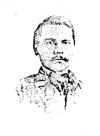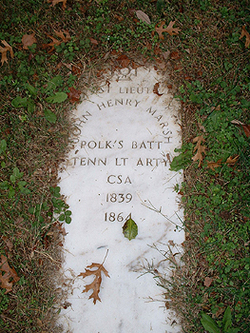Brigadier General Otho French Strahl
Otho French Strahl was born in 1831 near Elliotts Cross Roads, Ohio. If you look at the photograph above, you'll notice that this Ohioan is wearing a Confederate Brigadier General's uniform. Both of his grandmothers had been raised in the South and he came to appreciate their Southern heritage. After graduating from Ohio Wesleyan University, he read law and moved to Dyersburg, Tennessee where he opened his law practice.
When the Civil War began, Strahl became a captain in the 4th Tennessee Infantry. He had been promoted to Lieutenant Colonel by the time the regiment fought at Shiloh. Following that battle, the unit was consilidated with and became known as the 5th Tennessee Infantry. Strahl then became the regiment's colonel. Strahl would serve throughout the war and eventually be commissioned brigadier general of a Tennessee brigade.

Lieutenant John H. Marsh
Standing on Winstead Hill before the Battle of Franklin, Strahl was with one of his staff officers named John H. Marsh. Marsh was a lieutenant. The men of Strahl's brigade could overhear Brigadier General Mark Perrin Lowrey to their right giving his brigade a speech. Yet, Brigadier General Strahl remained quiet with a look of sadness on his face. Chaplain Quintard, who had been presented with Strahl's horse the day before noticed Strahl had already decided this would be his last battle. Finally, Strahl said, "This fight will be short, but desperate."
When the order was given for the line to advance, Lieuteant Marsh rode forward ahead of the brigade while mounted on his white horse. When the horse was killed, Marsh charged forward on foot to within three hundred yards of the Federal main line when a bullet penetrated his brain and killed him instantly.
General Strahl continued with his brigade to the main line where they broke through and pushed the Federals back to their retrenched line. Strahl and his men remained in the ditch outside the main line and exchanged fire with the Federals in the retrenched line. The ditch outside the main line of works quickly filled with the dead and dying. Because of the breastworks being extended around the Carter Cotton Gin, enfilade fire was horrendous for Strahl's Brigade.

Strahl's Brigade suffered enfilade from troops near cotton gin
Sergeant Sumner Cunningham was in the ditch near Strahl. Strahl was standing in the ditch loading rifles and passing them up to the volunteers who mounted the embankment to fire toward the retrenched line at the Carter House. Cunningham loaded his Enfield and passed it to a man on the embankment. The man cocked the weapon and took deliberate aim when he was shot dead, tumbling into the ditch below.
Strahl then turned to Sergeant Cunningham and ordered him to mount the embankment. Cunningham didn't hesitate, but walked over the dead and wounded, standing with one foot on dead men and the other planted in the side of the embankment. Strahl then handed loaded rifles up to Cunningham. There was a man on Cunningham's right firing, but between them and the Columbia Pike about 50 feet to their right was not a living soul. All those had been shot down by the enfilade fire.
Sergeant Sumner Cunningham
Sergeant Cunningham realized the situation was hopeless. He turned to General Strahl to inquire whether they should surrender or attempt to race to the rear. He asked, "General, what shall we do?" Strahl replied, "Keep firing."
At that moment, Strahl was shot down in the ditch, Cunningham believed his commander had been killed. The man to his right was struck and fell against Cunningham's right shoulder, groaning in agony. Cunningham asked the man where he was wounded. General Strahl, thinking Cunningham was talking to him, raised himself up and announced he was shot in the neck and needed to turn command over to Colonel Stafford. Strahl then began to crawl over the dead and wounded in the ditch about twenty feet to where Colonel Stafford was standing.
Arriving at the position of his subordinate, Strahl found Colonel Stafford had been killed, yet his body was wedged in the ditch between the dead and wounded in such a way that he was still standing. Sumner Cunningham noted the next morning that he appeared standing as if ready to give commands to the dead.
Several men attempted to carry General Strahl to the rear, but he received another gunshot wound and finally a third that blew out the back of his head, killing him instantly. Sergeant Cunningham then raced for the rear to inform Major General John C. Brown of the state of affairs at the front. He encountered one of Brown's staff officers who informed him that Brown had been wounded and that Strahl was in command of the division now. For the first time, Cunningham realized that those in command had no idea how bad things had become. He then went in search of Major General Benjamin Cheatham to inform him.
Grave of General Strahl
Brigadier General Otho French Strahl rests today in Dyersburg, Tennessee beneath the cannon shown above. Lieutenant John Marsh was carried with his commander's body to St. John's Episcopal Church just south of Columbia, Tennessee and buried by his side. Following the war, Strahl would be reinterred in Dyersburg, but Marsh still rests at St. John's.

Grave of Lieutenant John Henry Marsh

No comments:
Post a Comment